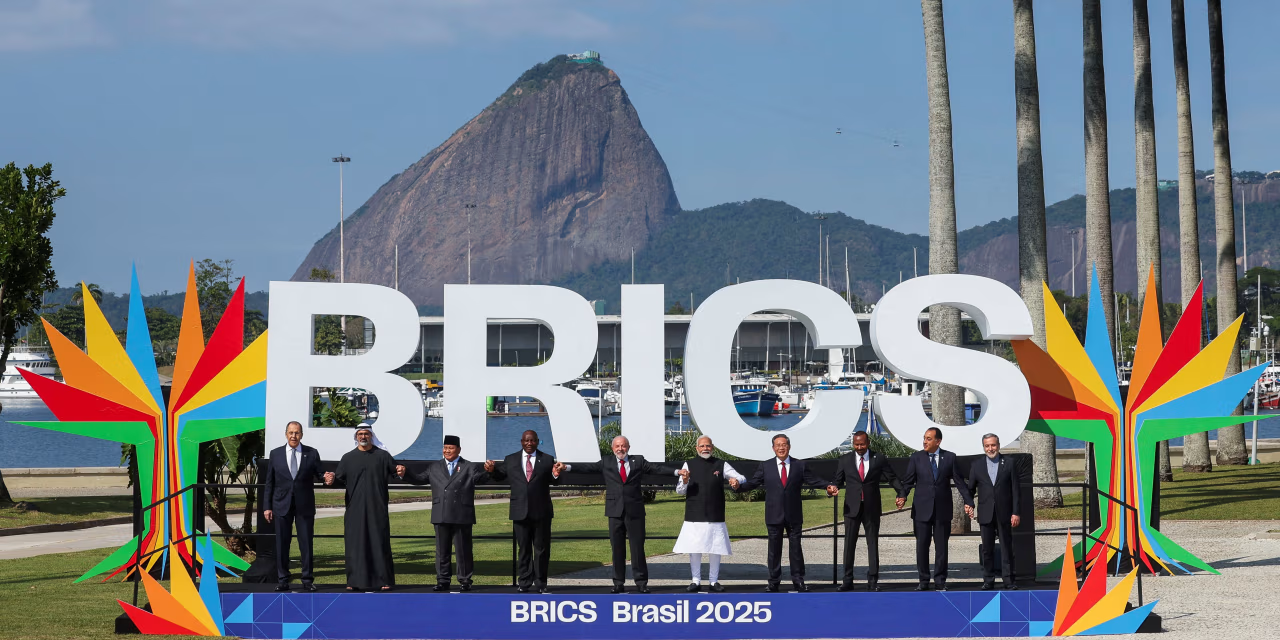Leaders of Brazil, Russia, India, China, South Africa and new BRICS+ members unite amid shifting global power.
Leaders of the BRICS nations are convening in Rio de Janeiro for a three-day summit to discuss strategies to deepen economic cooperation, enhance technology exchanges, and strengthen their position in global affairs. The gathering, which began on Sunday, July 6, 2025, takes place amid renewed global uncertainty, including renewed trade tensions sparked by former U.S. President Donald Trump’s tariff threats.
Brazilian President Luiz Inácio Lula da Silva is hosting the event, which is being attended by Indian Prime Minister Narendra Modi, Chinese Premier Li Qiang, and representatives from several other member states. Russia is being represented by a delegation, as President Vladimir Putin remains absent due to an active International Criminal Court warrant.
The Origins of BRICS and Its Alternative Vision
The BRICS grouping emerged from a concept introduced by Goldman Sachs economist Jim O’Neill in 2001. He identified Brazil, Russia, India, and China as rapidly growing economies capable of reshaping the global balance of power by 2050. The bloc formally began holding summits in 2009, and South Africa joined in 2010, giving rise to the current acronym.
Unlike traditional alliances, BRICS countries differ significantly in political systems and economic structures but share a mutual interest in promoting a multipolar world order. The group has since launched the New Development Bank (NDB) as an alternative to the World Bank, and it has discussed creating a new common currency to reduce dependency on the U.S. dollar—though that initiative remains stalled, partly due to resistance from India.
Who Has Joined and Who Wants In
Today, BRICS comprises ten full members, including the five founding nations plus Egypt, Ethiopia, Iran, the United Arab Emirates, and Indonesia, all of whom officially joined in early 2025. Dozens of other nations are seeking to align with the group, including Belarus, Bolivia, Cuba, Kazakhstan, Malaysia, Thailand, Vietnam, Uganda, and Uzbekistan, who are already considered BRICS+ associates.
According to the bloc’s website, more than 40 countries have submitted formal or exploratory applications for membership. Notably, Saudi Arabia—despite close ties with the U.S.—is listed as a future member, although a final decision has not yet been made. Meanwhile, Argentina withdrew its application under President Javier Milei, citing its preference to maintain stronger relations with Western nations.
India has vetoed the inclusion of Turkey due to its growing alignment with Pakistan, illustrating internal tensions that complicate further expansion.
A Diverse but Uneven Alliance
Despite lacking a formal charter or permanent secretariat, BRICS now accounts for over 40% of the world’s population and nearly one-third of global GDP when measured by purchasing power parity. The group also controls vast natural resources, including 40% of global oil output and over 70% of rare earths, positioning it as a critical player in global supply chains.
The Brazilian Center for International Relations reports that from 2009 to 2023, BRICS nations filed over 44 million patents, representing more than half of all patents worldwide. The NDB has also approved more than $39 billion USD in funding for over 120 infrastructure and sustainability projects.
Internal Contradictions and Geopolitical Challenges
The bloc’s ideological diversity has increasingly sparked debate about its long-term viability. China and Russia continue to view BRICS as a geopolitical counterweight to Western influence, while India and Brazil have emphasized economic integration rather than confrontation. Disputes such as the India-China border tensions and ongoing conflicts between Egypt and Ethiopia over the Nile River have underscored the bloc’s political divisions.
Moreover, economic disparities within the alliance—China’s economy is multiple times larger than those of Ethiopia or South Africa—raise concerns about dominance by a single member state. There is also growing scrutiny of how democratic nations within BRICS can maintain alignment with more authoritarian regimes like Russia, Iran, and China.
Even Jim O’Neill, who originally coined the BRICS term, recently expressed skepticism. In a 2024 op-ed, he stated that BRICS “lacks a coherent purpose beyond symbolic gestures and lofty rhetoric.”
What Comes Next?
Despite the skepticism, the BRICS summit in Rio is expected to produce concrete discussions on trade protocols, technological collaboration, and joint policy frameworks. While the group still faces structural and ideological hurdles, the rapid interest from countries across Africa, Asia, and Latin America suggests growing appeal for a system less reliant on U.S.-centric institutions.
If BRICS continues to expand and align around common interests—particularly in areas like digital infrastructure, sustainable development, and local currency trade—it could evolve into a powerful transregional coalition, reshaping how global diplomacy and trade are conducted in the years to come.







